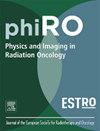Optimizing the dose-averaged linear energy transfer for the dominant intraprostatic lesions in high-risk localized prostate cancer patients
IF 3.4
Q2 ONCOLOGY
引用次数: 0
Abstract
Background and purpose
Radiotherapy for localized prostate cancer often targets the entire prostate with a uniform dose despite the presence of high-risk dominant intraprostatic lesions (DILs). This study investigated the feasibility of focal dose-averaged linear energy transfer (LETd) boost for prostate carbon-ion radiotherapy to deposit higher LETd to DILs while ensuring desired relative biological effectiveness weighted dose coverage to targets and sparing organs at risk (OARs).
Materials and methods
A retrospective planning study was conducted on 15 localized prostate cancer cases. The DILs were identified on multiparametric MRI and used to define the boost target (PTVboost). Two treatment plans were designed for each patient: 1) conventional plan optimized by the single-field uniform dose technique, and 2) boost plan optimized by the multifield optimization and LET painting technique, to achieve LETd boost within the PTVboost. Dose and LETd metrics of the targets and OARs were compared between the two plans.
Results
Compared to the conventional plans, the boost plans delivered clinically acceptable dose coverage (D90% and D50%) to the target (PTV2) within 1% differences while significantly increasing the minimum LETd by 16 ∼ 24 keV/μm for the PTVboost (63.9 ± 2.8 vs. 44.0 ± 1.3 keV/μm, p < 0.001). Furthermore, these improvements were consistent across all cases, irrespective of their anatomical features, including the boost volume’s size, location, and shape.
Conclusion
Focal LETd boost was a feasible strategy for prostate carbon-ion radiotherapy. This investigation demonstrated its superiority in delivering LETd boost without depending on tumor location and volume across different cases.
优化高危局限性前列腺癌患者前列腺内显性病变的剂量平均线性能量转移
背景和目的局部前列腺癌的放射治疗通常以均匀剂量靶向整个前列腺,尽管存在高风险的显性前列腺内病变(DILs)。本研究探讨了前列腺碳离子放疗的局灶剂量平均线性能量转移(LETd)增强的可行性,以在确保所需的相对生物有效性的同时,将更高的LETd沉积到DILs,同时确保对目标的加权剂量覆盖和保留危险器官(OARs)。材料与方法对15例局限性前列腺癌患者进行回顾性计划研究。在多参数MRI上识别dil并用于确定升压目标(PTVboost)。为每位患者设计两种治疗方案:1)采用单场均匀剂量技术优化的常规方案,2)采用多场优化和LET喷涂技术优化的boost方案,在PTVboost内实现LETd boost。比较两种方案中靶细胞和桨细胞的剂量和led指标。结果与常规方案相比,boost方案对目标(PTV2)的临床可接受剂量覆盖率(D90%和D50%)差异在1%以内,同时显著提高PTVboost的最小LETd 16 ~ 24 keV/μm(63.9±2.8 vs. 44.0±1.3 keV/μm, p <;0.001)。此外,这些改善在所有病例中都是一致的,无论其解剖特征如何,包括增压体积的大小、位置和形状。结论病灶强化是一种可行的前列腺碳离子放射治疗策略。这项研究表明,在不同的病例中,它在不依赖肿瘤位置和体积的情况下提供LETd增强方面具有优势。
本文章由计算机程序翻译,如有差异,请以英文原文为准。
求助全文
约1分钟内获得全文
求助全文
来源期刊

Physics and Imaging in Radiation Oncology
Physics and Astronomy-Radiation
CiteScore
5.30
自引率
18.90%
发文量
93
审稿时长
6 weeks
 求助内容:
求助内容: 应助结果提醒方式:
应助结果提醒方式:


